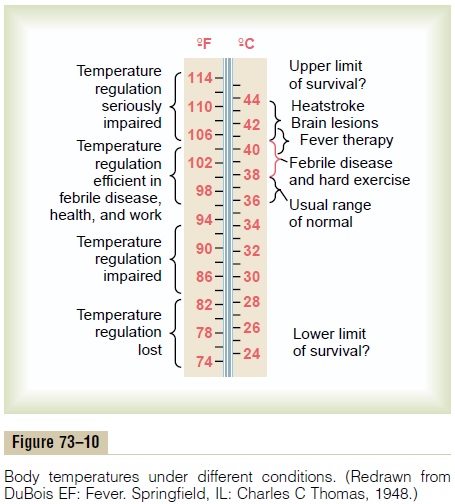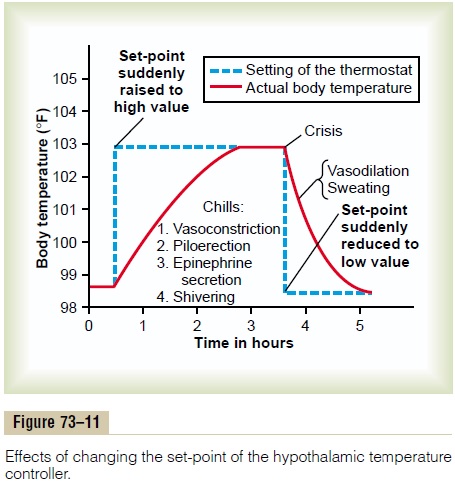Chapter: Medical Physiology: Body Temperature, Temperature Regulation, and Fever
Abnormalities of Body Temperature Regulation
Abnormalities of BodyTemperature Regulation
Fever
Fever, which means a body temperature above the usual range of normal, can be caused by abnormalities in the brain itself or by toxic substances that affect the temperature-regulating centers. Some causes of fever(and also of subnormal body temperatures) are pre-sented in Figure 73–10.They include bacterial diseases,

Resetting the Hypothalamic Temperature- Regulating Center in Febrile Diseases— Effect of Pyrogens
Many proteins, breakdown products of proteins, and certain other substances, especially lipopolysaccharide toxins released from bacterial cell membranes, can cause the set-point of the hypothalamic thermostat to rise. Substances that cause this effect are called pyro-gens. Pyrogens released from toxic bacteria or thosereleased from degenerating body tissues cause fever during disease conditions. When the set-point of the hypothalamic temperature-regulating center becomes higher than normal, all the mechanisms for raising the body temperature are brought into play, including heat conservation and increased heat production. Within a few hours after the set-point has been increased, the body temperature also approaches this level, as shown in Figure 73–11.

Mechanism of Action of Pyrogens in Causing Fever—Role of Interleukin-1. Experiments in animals have shown thatsome pyrogens, when injected into the hypothalamus, can act directly and immediately on the hypothalamic temperature-regulating center to increase its set-point. Other pyrogens function indirectly and may require several hours of latency before causing their effects.
This is true of many of the bacterial pyrogens, espe-cially the endotoxins from gram-negative bacteria.
When bacteria or breakdown products of bacteria are present in the tissues or in the blood, they are phagocytized by the blood leukocytes, by tissue macrophages, and by large granular killer lymphocytes.
All these cells digest the bacterial products and the release the substance interleukin-1—also called leuko-cyte pyrogen or endogenous pyrogen—into the bodyfluids. The interleukin-1, on reaching the hypothala-mus, immediately activates the processes to produce fever, sometimes increasing the body temperature a noticeable amount in only 8 to 10 minutes. As little asone ten-millionth of a gram of endotoxin lipopolysac-charide from bacteria, acting in concert with the bloodleukocytes, tissue macrophages, and killer lympho-cytes, can cause fever.The amount of interleukin-1 that is formed in response to lipopolysaccharide to cause fever is only a few nanograms.
Several experiments have suggested that inter-leukin-1 causes fever by first inducing the formation of one of the prostaglandins, mainly prostaglandin E2, or a similar substance, which acts in the hypothalamus to elicit the fever reaction. When prostaglandin forma-tion is blocked by drugs, the fever is either completely abrogated or at least reduced. In fact, this may be the explanation for the manner in which aspirin reduces fever, because aspirin impedes the formation of prostaglandins from arachidonic acid. Drugs such as aspirin that reduce fever are called antipyretics.
Fever Caused by Brain Lesions. When a brain surgeonoperates in the region of the hypothalamus, severe fever almost always occurs; rarely, the opposite effect, hypothermia, occurs, demonstrating both the potency of the hypothalamic mechanisms for body tempera-ture control and the ease with which abnormalities of the hypothalamus can alter the set-point of tempera-ture control. Another condition that frequently causes prolonged high temperature is compression of the hypothalamus by a brain tumor.
Characteristics of Febrile Conditions Chills. When the set-point of the hypothalamictemperature-control center is suddenly changed from the normal level to higher than normal (as a result of tissue destruction, pyrogenic substances, or dehydra-tion), the body temperature usually takes several hours to reach the new temperature set-point.
Figure 73–11 demonstrates the effect of suddenly increasing the temperature set-point to a level of 103°F. Because the blood temperature is now less than the set-point of the hypothalamic temperature controller, the usual responses that cause elevation of body tempera-ture occur. During this period, the person experiences chills and feels extremely cold, even though his or her body temperature may already be above normal. Also, the skin becomes cold because of vasoconstriction, and the person shivers. Chills can continue until the body temperature reaches the hypothalamic set-point of 103°F. Then the person no longer experiences chills but instead feels neither cold nor hot. As long as the factor that is causing the higher set-point of the hypo-thalamic temperature controller is present, the body temperature is regulated more or less in the normal manner, but at the high temperature set-point level.
Crisis, or “Flush.” If the factor that is causing the hightemperature is removed, the set-point of the hypothal-amic temperature controller will be reduced to a lower value—perhaps even back to the normal level, as shown in Figure 73–11. In this instance, the body temperature is still 103°F, but the hypothalamus is attempting to regulate the temperature to 98.6°F. This situation is analogous to excessive heating of the anterior hypothalamic-preoptic area, which causes intense sweating and the sudden development of hot skin because of vasodilation everywhere.This sudden change of events in a febrile state is known as the “crisis” or, more appropriately, the “flush.” In the days before the advent of antibiotics, the crisis was always anxiously awaited, because once this occurred, the doctor assumed that the patient’s temperature would soon begin falling.
Heatstroke
The upper limit of air temperature that one can stand depends almost entirely on whether the air is dry or wet. If the air is dry and sufficient convection air currents are flowing to promote rapid evaporation from the body, a person can withstand several hours of air temperature at 130°F. Conversely, if the air is 100 per cent humidi-fied or if the body is in water, the body temperature begins to rise whenever the environmental temperature rises above about 94°F. If the person is performing heavy work, the critical environmental temperatureabove which heatstroke is likely to occur may be as low as 85° to 90°F.
When the body temperature rises beyond a critical temperature, into the range of 105° to 108°F, the person is likely to develop heatstroke. The symptoms include dizziness, abdominal distress sometimes accompanied by vomiting, sometimes delirium, and eventually loss of consciousness if the body temperature is not soon decreased. These symptoms are often exacerbated by a degree of circulatory shock brought on by excessive loss of fluid and electrolytes in the sweat.
The hyperpyrexia itself is also exceedingly damaging to the body tissues, especially the brain, and is respon-sible for many of the effects. In fact, even a few minutes of very high body temperature can sometimes be fatal. For this reason, many authorities recommend immediate treatment of heatstroke by placing the person in a cold water bath. Because this often induces uncontrollable shivering, with a considerable increase in the rate of heat production, others have suggested that sponge or spray cooling of the skin is likely to be more effective for rapidly decreasing the body core temperature.
Harmful Effects of High Temperature. The pathological find-ings in a person who dies of hyperpyrexia are local hemorrhages and parenchymatous degeneration of cells throughout the entire body, but especially in the brain. Once neuronal cells are destroyed, they can never be replaced. Also, damage to the liver, kidneys, and other organs can often be severe enough that failure of one or more of these organs eventually causes death, but sometimes not until several days after the heatstroke.
Acclimatization to Heat. It can be extremely importantto acclimatize people to extreme heat. Examples of people requiring acclimatization are soldiers on duty in the tropics and miners working in the 2-mile-deep gold mines of South Africa, where the temperature approaches body temperature and the humidity approaches 100 per cent. A person exposed to heat for several hours each day while performing a reasonably heavy workload will develop increased tolerance to hot and humid conditions in 1 to 3 weeks.
Among the most important physiological changes that occur during this acclimatization process are an approximately twofold increase in the maximum rate of sweating, an increase in plasma volume, and diminished loss of salt in the sweat and urine to almost none; the last two effects result from increased secretion of aldos-terone by the adrenal glands.
Exposure of the Body to Extreme Cold
Unless treated immediately, a person exposed to ice water for 20 to 30 minutes ordinarily dies because of heart standstill or heart fibrillation. By that time, the internal body temperature will have fallen to about 77°F. If warmed rapidly by the application of external heat, the person’s life can often be saved.
Loss of Temperature Regulation at Low Temperatures. As notedin Figure 73–10, once the body temperature has fallen below about 85°F, the ability of the hypothalamus to regulate temperature is lost; it is greatly impaired even when the body temperature falls below about 94°F. Part of the reason for this diminished temperature regula-tion is that the rate of chemical heat production in each cell is depressed almost twofold for each 10°F decrease in body temperature. Also, sleepiness develops (later followed by coma), which depresses the activity of the central nervous system heat control mechanisms and prevents shivering.
Frostbite. When the body is exposed to extremely lowtemperatures, surface areas can freeze; the freezing is called frostbite. This occurs especially in the lobes of the ears and in the digits of the hands and feet. If the freeze has been sufficient to cause extensive formation of ice crystals in the cells, permanent damage usually results, such as permanent circulatory impairment as well as local tissue damage. Often gangrene follows thawing, and the frostbitten areas must be removed surgically.
Cold-Induced Vasodilation Is a Final Protection Against Frostbite at Almost Freezing Temperatures. When thetemperature of tissues falls almost to freezing, the smooth muscle in the vascular wall becomes paralyzed because of the cold itself, and sudden vasodilation occurs, often manifested by a flush of the skin. This mechanism helps prevent frostbite by delivering warm blood to the skin. This mechanism is far less developed in humans than in most lower animals that live in the cold all the time.
Artificial Hypothermia. It is easy to decrease the tempera-ture of a person by first administering a strong sedative to depress the reactivity of the hypothalamic tempera-ture controller and then cooling the person with ice or cooling blankets until the temperature falls. The tem-perature can then be maintained below 90°F for several days to a week or more by continual sprinkling of cool water or alcohol on the body. Such artificial cooling has been used during heart surgery so that the heart can be stopped artificially for many minutes at a time. Cooling to this extent does not cause tissue damage, but it does slow the heart and greatly depresses cell metabolism, so that the body’s cells can survive 30 minutes to more than 1 hour without blood flow during the surgical procedure.
Related Topics